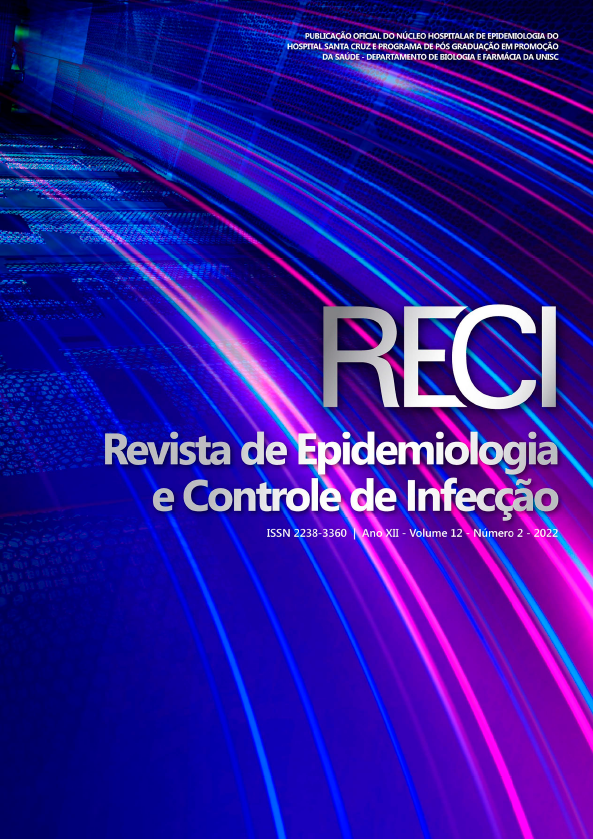Inappropriate empirical antimicrobial treatment in bloodstream infections patients in the era of multidrug resistance
DOI:
https://doi.org/10.17058/reci.v12i2.16855Keywords:
Pseudomonas aeruginosa, Carbapenem, bloodstream infection, mortalityAbstract
Background and objectives: Bloodstream infection (BSI) by multidrug-resistant Pseudomonas aeruginosa is a severe infection. This study aimed to evaluate and identify the predictors of mortality in patients who had bloodstream infection by carbapenem-resistant P. aeruginosa. Methods: This is a retrospective cohort study, approved by Committee of Ethics in Research with Human Participants, which included 87 consecutive patients hospitalized in a referral hospital in Brazil. Clinical and demographic information about each patient were obtained from hospital records. The Student’s T-test was used to compare continuous variables and x2 or Fisher’s exact tests to compare categorical variables. To determine independent risk factors for 30-day mortality, a multiple logistic regression model was used. A survival curve was constructed using the Kaplan–Meier method. Results: Among the patients, 87.3% use antibiotics previously, 60.9% received inadequate empirical treatment, and the 30-day mortality rate was 57.5%. Inappropriate antibiotic empirical therapy was independently associated with a 30-days death and mortality rate. Conclusion: These findings can show some insights about the relationship between higher mortality and inappropriate empirical therapy for patients with BSI by P. aeruginosa. There is a need for better diagnostic tests and infection control programs should focus on de-escalation the antibiotic inappropriate therapy, mainly in BSI caused by carbapenem-resistant P. aeruginosa.
Downloads
References
Ponce de Leon A, Merchant S, Raman G., et al. Pseudomonas infections among hospitalized adults in Latin America: a systematic review and meta-analysis. BMC Infect Dis. 2020; 20: 250. https://doi.org/10.1186/s12879-020-04973-0.
Gonçalves IR, Dantas RCC, Ferreira ML, et al. Carbapenem-resistant Pseudomonas aeruginosa: association with virulence genes and biofilm formation. Braz J Microbiol. 2017; 48: 211-217. https://doi.org/10.1016/j.bjm.2016.11.004.
Rojas A, Palacios-Baena ZR, López-Cortés LE, et al. Rates, predictors and mortality of community-onset bloodstream infections due to Pseudomonas aeruginosa: systematic review and meta-analysis. Clin Microbiol Infect. 2019; 25 (8): 964-970.
https://doi.org/10.1016/j.cmi.2019.04.005
Parkins MD, Somayaji R, Waters VJ. Epidemiology, Biology, and Impact of Clonal Pseudomonas aeruginosa Infections in Cystic Fibrosis. Clin Microbiol Rev. 2018; 31(4):e00019-18. https://doi.org/10.1128/cmr.00019-18.
De Oliveira Santos IC, Pereira de Andrade NF, da Conceição Neto OC, et al. Epidemiology and antibiotic resistance trends in clinical isolates of Pseudomonas aeruginosa from Rio de Janeiro - Brazil: Importance of mutational mechanisms over the years (1995-2015). Infect Genet Evol. 2019; 73: 411-415. https://doi.org/10.1016/j.meegid.2019.05.015
Braga IA, Campos PA, Gontijo-Filho PP, et al. Multi-hospital point prevalence study of healthcare-associated infections in 28 adult intensive care units in Brazil. J Hosp Infect. 2018; 99 (3): 318-324. https://doi.org/10.1016/j.jhin.2018.03.003
Botelho J, Grosso F, Peixe L. Antibiotic resistance in Pseudomonas aeruginosa - Mechanisms, epidemiology and evolution. Drug Resist Updat. 2019; 44: 100640. https://doi.org/10.1016/j.drup.2019.07.002
Bassetti M, Righi E, Carnelutti A. Bloodstream infections in the Intensive Care Unit. Virulence. 2016; 7: 267-279. https://doi.org/10.1080/21505594.2015.1134072
Ruiz-Garbajosa P, Cantón R. Epidemiology of antibiotic resistance in Pseudomonas aeruginosa. Implications for empiric and definitive therapy. Rev Esp Quimioter. 2017; 30 (1): 8-12.
Daikos GL, Tsaousi S, Tzouvelekis LS, et al. Carbapenemase-producing Klebsiella pneumoniae bloodstream infections: lowering mortality by antibiotic combination schemes and the role of carbapenems. Antimicrob Agents Chemother. 2014; 58 (4): 2322-8. https://doi.org/10.1128/AAC.02166-13
Magiorakos AP, Srinivasan A, Carey RB, et al. Multidrug-resistant, extensively drug-resistant and pandrug-resistant bacteria: an international expert proposal for interim standard definitions for acquired resistance. Clin Microbiol Infect. 2012; 18 (3): 268–281. https://doi.org/10.1111/j.1469-0691.2011.03570.x
Balkhair A, Al-Muharrmi Z, Al'Adawi B, et al. Prevalence and 30-day all-cause mortality of carbapenem-and colistin-resistant bacteraemia caused by Acinetobacter baumannii, Pseudomonas aeruginosa, and Klebsiella pneumoniae: Description of a decade-long trend. Int J Infect Dis. 2019; 85:10-15. https://doi.org/10.1016/j.ijid.2019.05.004
Dias VC, Resende JA, Bastos AN, et al. Epidemiological, Physiological, and Molecular Characteristics of a Brazilian Collection of Carbapenem-Resistant Acinetobacter baumannii and Pseudomonas aeruginosa. Microb Drug Resist. 2017; 23(7):852-863. https://doi.org/10.1089/mdr.2016.0219.
Balkhair A, Al-Muharrmi Z, Al'Adawi B, et al. Prevalence and 30-day all-cause mortality of carbapenem-and colistin-resistant bacteraemia caused by Acinetobacter baumannii, Pseudomonas aeruginosa, and Klebsiella pneumoniae: Description of a decade-long trend. Int J Infect Dis. 2019; 85:10-15. https://doi.org/10.1016/j.ijid.2019.05.004.
Tsao LH, Hsin CY, Liu HY, et al. Risk factors for healthcare-associated infection caused by carbapenem-resistant Pseudomonas aeruginosa. J Microbiol Immunol Infect. 2018; 51(3):359-366. https://doi.org/10.1016/j.jmii.2017.08.015.
Martinez-Nadal G, Puerta-Alcalde P, Gudiol C, et al. Inappropriate empirical antibiotic treatment in high-risk neutropenic patients with bacteremia in the Era of Multidrug Resistance. Clin Infect Dis. 2020; 70 (6): 1068–74. https://doi.org/10.1093/cid/ciz319
Montero MM, López Montesinos I, Knobel H, et al. Risk Factors for Mortality among Patients with Pseudomonas aeruginosa Bloodstream Infections: What Is the Influence of XDR Phenotype on Outcomes? J Clin Med. 2020; 9 (2): 514. https://doi.org/10.3390/jcm9020514
Garcia-Vidal C, Cardozo-Espinola C, Puerta-Alcalde P, et al. Risk factors for mortality in patients with acute leukemia and bloodstream infections in the era of multiresistance. PLoS One. 2018; 13 (6): e0199531. https://doi.org/10.1371/journal.pone.019953
Downloads
Published
How to Cite
Issue
Section
License
Copyright (c) 2022 Jane Eire Urzedo, Ralciane de Paula Menezes, Melina Lorraine Ferreira, Cristiane Silveira de Brito, Raquel Cristina Cavalcanti Dantas, Paulo Pinto Gontijo Filho, Rosineide Marques Ribas

This work is licensed under a Creative Commons Attribution 4.0 International License.
The author must state that the paper is original (has not been published previously), not infringing any copyright or other ownership right involving third parties. Once the paper is submitted, the Journal reserves the right to make normative changes, such as spelling and grammar, in order to maintain the language standard, but respecting the author’s style. The published papers become ownership of RECI, considering that all the opinions expressed by the authors are their responsibility. Because we are an open access journal, we allow free use of articles in educational and scientific applications provided the source is cited under the Creative Commons CC-BY license.


